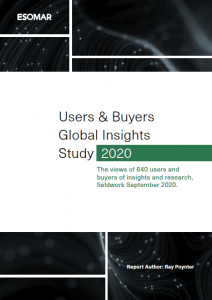ESOMAR heeft in september wereldwijd onderzoek gedaan onder 640 opdrachtgevers/gebruikers van insights en onderzoek. De studie, die voor de eerste keer is uitgevoerd, is bedoeld om een benchmark neer te zetten. Hoe wordt inzicht beoordeeld en gebruikt, en wat wordt verstaan onder goed en succesvol onderzoek? Belangrijke uitkomt: er is een verschuiving op komst naar onderzoek in eigen huis. Dat is al een tendens, maar hij wordt de komende tijd sterker. Corona helpt eraan mee (vanwege de kosten). Goed omgaan met data blijft een rol spelen, en er komt meer nadruk op efficiënt en ‘basic’ onderzoek, o.a. om consumentengedrag in deze onzekere tijden goed te volgen. ESOMAR heeft ook nog een aantal aanbevelingen.
Executive Summary
Here are the views of 640 buyers and users of research from around the world, expressing their views, concerns and intentions in terms of insights.
The Big Picture
There is a shift towards more research being conducted internally by the buyers and users of insights which is expected to amount to 50% of all projects within a year or two. The main challenge clients and users are facing at the moment relates to resource and COVID-19. The key phrase is ‘doing more with less’. The key focus relates to how best to leverage conventional research in a data and regulation rich world, where consumer behaviour appears to be changing quickly.
Projects are shifting to internal
Clients and users of insights told us that about 40% of their research projects are being conducted internally, with a wide variation from 0% to 100%. Further, nearly 50% said the internal share is increasing. This leads us to forecast that within a year or two 50% of research will be conducted internally.
COVID-19 and the Recession are currently the key challenges
Cuts in budget, shortages of resources, changes in consumer behaviour, and the need to conduct more research are currently the key drivers (behind the increase in projects being conducted internally). Whilst there are plenty of exceptions, this is the focus for most buyers and users of insights.
The near future is about core research, not the cutting edge
In addition to dealing with resource and COVID related issues, our participants had a number of other topics that they saw as key for 2021 and the next few years. For example, compliance and competence with data rules and ethics, the ability to measure changes in consumer behaviour, and the ability to be able to provide fast, easy to assimilate links to wider processes, are all going to be important. The main consequence seems to be a shift away from the cutting edge (e.g. chatbots) towards simple research done efficiently (and ethically).
Key Priority for Buyers/Users
The key point is to be able to service the business needs, not necessarily to build a bigger insights team. The flow of projects from external partners to internal should also be a democratisation flow from insight teams to the rest of the organisation. The process of bringing research internal should reflect the key strengths of agencies and internal teams, which differs by company, vertical, and region.
Key Priority for Suppliers


